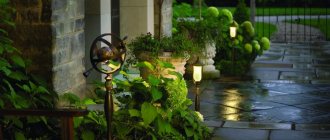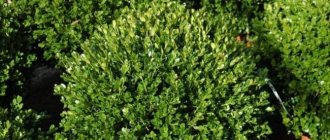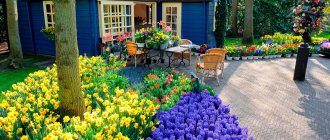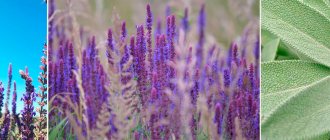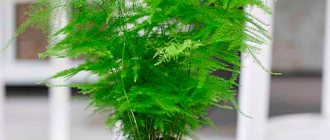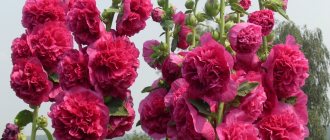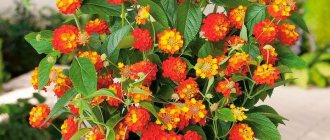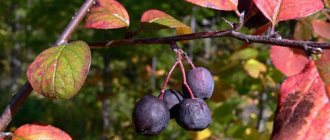The Austrian botanist Heinrich Wilhelm Schott, in search of unique and beautiful plants for the imperial botanical garden at Schönbrunn Palace in Vienna, studied and typed several previously unknown species of tropical flora. He liked the large dark green leaves with contrasting white speckles. So from the South American tropics the flower migrated to all greenhouses and houses. It was named after the surname of the chief gardener of the Imperial Palace Greenhouse in Vienna, Joseph Dieffenbach.
For more than 100 years, the exotic flower has been growing not only in its historical homeland. It decorates apartments and offices all over the world. This plant of the araceae family has never adapted to the cold climate. It still needs warmth, humidity and bright light. This should be taken into account when choosing Dieffenbachia for interior landscaping.
Description of the species
The plant has a thick stem with many large spotted leaves. The shoots are usually located at the top, which is why over time Dieffenbachia becomes like a real tree with a lush, dense rosette at the top and a long bare trunk at the bottom. However, some species have several growth zones and are more like a bush. The height can reach a little over two meters. Like other aroids, it blooms with an ear. At the site of the inflorescence, small orange berries are formed. At home, this happens extremely rarely; to ensure the plant has a full growing season, it requires very careful and professional care.
Thanks to its large foliage, the plant provides many benefits as a natural air filter. It’s not for nothing that the Amazon rainforest is called the lungs of the planet. The amount of oxygen produced by large-leaf evergreens is colossal.
At the moment, about fifty varieties are known to botany. All of them have a characteristic feature - toxicity. The fact is that Dieffenbachia juice contains a large amount of caustic enzymes and calcium oxalate crystals.
When it comes into contact with the skin, it causes an allergy, and in case of contact with mucous membranes, it causes a severe burn. Therefore, it is better not to keep the plant in a house where there are animals and small children, and wear rubber gloves when caring for and pruning.
Dieffenbachia types and description
Many types of Dieffenbachia have large oval leaves. The color of the leaves is from light to dark green with spots, dots, and streaks. It is thanks to the leaves that the flower is so valued by florists and has been cultivated for 150 years. Dieffenbachia grows as a bush or has a tree-like trunk. It depends on the varietal and species. The most frequent guests among flowers grown at home are the following types of Dieffenbachia.
Camilla
Aglaonema indoor flower - types and flowering
Dieffenbachia Camilla is one of the most famous dieffenbachia varieties. The leaves are thick and wide, with cream and dark green streaks. As the plant matures, the contrast with the green edges of the leaf smoothes out. This lush bush grows quickly at home, but does not reach significant height. Within a week, a new leaf grows. This type of flower does not bloom even with good care at home. The best place where Camilla will feel good is a shaded corner in a ventilated room, but the plant does not like drafts. Camilla needs well-drained soil.
Something to remember! Dieffenbachia Camilla leaves are toxic, which can affect the health of pets who decide to taste the plant.
Compacta
Dieffenbfhia compacta is an unpretentious plant, so it is popular in homes and offices. Its colorful, large white leaves on upright stems adorn this plant. Typically Compacta has a height of 90 to 180 cm and a bush spread of 30 to 100 cm. Individual leaves can be 45 cm long and 30 cm wide.
Compacta
Mix
The Dieffenbachia Mix species can be observed in natural conditions in the subtropical climate of South and Central America. At home, this flower has the appearance of a shrub up to 65 cm high. The mix feels normal in both homes and office spaces, and responds well to a sufficient amount of natural light.
Attention! The leaves of the plant are light green in color with intricate patterns. The appearance of Mix is very similar to Leopold Dieffenbachia, one of the most decorative varieties grown at home.
Reflector
Dieffenbachia Reflector is called the tiger plant due to its interesting “camouflage” colors. It is known for its variety of leaf colors and air purifying effect. The Reflector variety has large, light green leaves with dark spots, making them stand out in the home. Grows well in rooms where the minimum air temperature is +17°C. The maximum plant height is up to 90 cm.
Feels good both on the window and in places with less sunlight. In summer, you should avoid direct sunlight, which can burn the leaves through the glass. Caring for Dieffenbachia flowers at home is simple. It is enough to water it once a week to prevent the roots from rotting from excess moisture.

Dieffenbachia Reflector
Tropic Snow
An attractive indoor decorative foliage plant is Dieffenbachia Tropic Snow. This is a light-loving variety of flower, but it also grows well in shaded areas of the room, especially in the summer. It has a height of more than a meter. If the plant stem grows strictly vertically, there is enough light. If the trunk has even a minimal slope, there is not enough light. Florists recommend rotating the plant 180° so that the crown has an even shape.
Proportional, oar-shaped leaves are held on short stems and have an original pattern. The plant loves watering throughout the growing season. The soil must dry out for at least 3 days so that the roots do not rot if there is excess moisture. In winter, Dieffenbachia needs to be watered less often, with settled soft water without chlorine and fluorine.
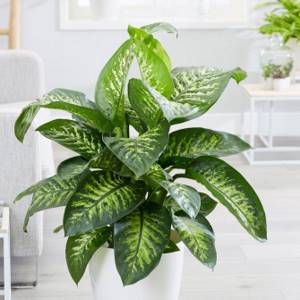
Tropic Snow
Dieffenbachia leaves should be kept clean, wiped with a damp cloth or washed to remove dust in the shower. Tropic Snow does not like drafts. The optimal temperature in winter should be above +15°C. Flower growers recommend planting and propagating the plant in the spring.
Attention! The plant is toxic and irritates the skin and eyes. After working with it, you need to wash your hands thoroughly, regardless of the fact that it was done in gardening gloves.
Lovely
The appearance of this Dieffenbachia is tree-like. It has a fleshy stem and large leaves that look like an ellipse with a pointed end. Their length can reach 50 cm. The leaves are rich green in color with white streaks and veins. This species is shade-tolerant and resistant to unfavorable conditions.
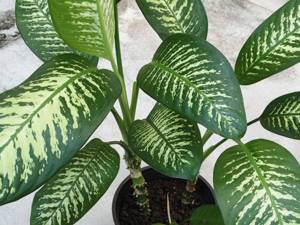
Lovely
Vesuvius
This type of Dieffenbachia does not pretend to be decorative, but is beneficial by purifying the air of toxins. Like all species of this plant, its juice is poisonous. Consequently, Vesuvius is not recommended to be kept in children's institutions. The flower does not like sudden cold spells and drafts and needs regular watering and pruning. Flowering occurs rarely.
Seguina
Dieffenbachia Seguina is a herbaceous plant native to the Caribbean. Cultivated as an outdoor ornamental plant. The stems are 1.5 m high. The genetic diversity is relatively high compared to other Dieffenbachia species. The flower can bloom in natural conditions from March to September, as it is pollinated by beetles.
Green Magic
Hybrid Dieffenbachia Green Magic has a bush form with compact dimensions. It is obtained on the basis of the Ørsted variety.
Spotted
Spotted Dieffenbachia is sometimes called painted because of the color of the leaves, which resemble patterns of various shapes and sizes. This is a tree-like crop with a powerful stem. Grows to approximately 1 meter in height. The leaves are 40x10 cm in size. This Dieffenbachia blooms and has ripe orange fruit. Its spotting on the leaves is similar to the spotted variety of Dieffenbachia Mars.
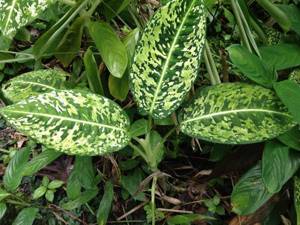
Spotted
Green
The fast-growing Dieffenbachia green tree has fairly large leaves. It looks great in the interior and purifies the air of toxins. It is good to have such a flower in offices located in environmentally polluted areas of the city. Requires regular spraying or washing of leaves. Watering should be moderate so that the soil has time to dry out.
Indoor subspecies
Despite all the variety of varieties of Dieffenbachia, most of them do not take root in captivity. The most resistant to artificial lighting, temperature changes and dry air became the progenitors of decorative indoor varieties.
| Name | Description and features of the species |
| Dieffenbachia spotted (cultivars: Camilla, Tropic Snow, Bauze) | A massive plant up to a meter high with wide lanceolate leaves. The characteristic color is dark green with contrasting light spots, which can range in size from small dots to large veins that occupy almost the entire surface. |
| Dieffenbachia lovely (Seguina) | A shade-tolerant plant with a large lush rosette of wide (up to 18 cm in diameter) spotted leaves. Unlike its relatives, it tolerates dry air better and is not demanding on the microclimate. |
| Dieffenbachia Leopolda | It has dark emerald green leaves with a characteristic light stripe along the central vein. In addition, purple specks may appear on the surface and stem. This is a bushy, low-growing plant. |
| Dieffenbachia Oersted | Bush subspecies with pointed, very light leaves. |
You can accurately determine the variety and not confuse it with other plants by comparing it with a photo.
Spotted and Variegated
They have a powerful stem and leaves that grow up to 12 cm wide and half a meter long. They are strewn with pale spots and stripes. The difference is that the first of them reaches only 1 m, and the second - 2 m.
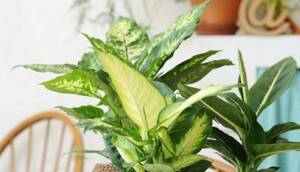
It was the first variety that became the basis for a large number of resulting hybrids:
- Vesuvio is graceful, medium in size. Color: soft white with green specks;
- Camilla is one of the persistent bushy varieties, which has earned it the recognition of beginners. The elongated, evenly green leaves are edged with a green rim.
- Compacta is a bushy and miniature specimen in all respects.

Plant care rules
When growing Dieffenbachia, you should remember that the birthplace of the flower is the tropical rainforest of South America. If you provide it with the appropriate microclimate, it grows quite quickly, producing one new leaf about once a week.
Despite all the whimsical nature of the flower, only a few simple conditions are required, which makes it ideal for an office, a large apartment and the halls of public institutions.
| Content Option | Required conditions |
| Lighting | The more pronounced the pattern, the higher the light requirements of the variety. For plain colors, moderate daylight lighting is sufficient. Direct sunlight should be avoided. |
| Hydration | Spraying should be done as a daily procedure. To do this, use warm filtered water. Placement near heating appliances is highly undesirable. |
| Watering | Do not allow a dry lump of earth to form in the pot. The soil should be moist, but not overwatered. Dieffenbachia also does not like dampness. |
| Temperature | The thermometer should not fall below +17 degrees. For summer, the optimal temperature will be +22-+28 Celsius, for winter: +18-+22 |
| Transfer | Infrequently, in proportion to root growth. |
| Fertilizer | It is best to feed the plant with nitrogen or complex preparations for indoor tropical plants with decorative leaves. This should be done from the beginning of spring to the end of autumn, once every two weeks, with a half dose of fertilizer, thoroughly diluted in water for irrigation. |
| The soil | The plant prefers slightly acidic, well-drained soil mixtures. Compositions of sand, peat, moss, perlite and crushed bark with charcoal are ideal. |
| Cultivation | Dieffenbachia needs to be pruned as it grows. The crown with the rosette is separated from the trunk, washed and rooted. The remaining stem is divided into bars with dormant buds. New shoots can be obtained from them. |
Dieffenbachia loves space and clean, fresh air. You can take it out onto loggias and verandas in the warm season, but you should not allow drafts or leave it outside during sudden temperature changes at night.
Features of care
Caring for Dieffenbachia at home is a simple process. If you follow all the recommendations, timely water, feed, prune and create a temperature regime that is comfortable for the flower, it will delight you with a fresh look and rapid growth.
Dieffenbachia has been used as a houseplant for about 200 years. During this time, experts conducted many experiments and came to the conclusion of how to properly maintain it.
Watering
Watering for a plant is as important as daily nutrition for a person. It's important not to overdo it. It is necessary to water as the soil dries out so that the water does not stagnate in the pan.
Attention! It should be noted that in summer Dieffenbachia requires abundant watering, in contrast to the winter season.
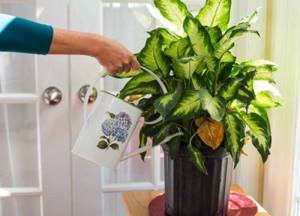
Drying out should not be allowed, so the plant should not be left unattended for a long time.
In case of excessive watering, it is necessary to correct the situation.
The plant can be removed from the pot along with the soil and wrapped in kitchen towels or microfiber cloths. They will quickly absorb moisture.
Air temperature and humidity
For full development and growth, Dieffenbachia requires a certain temperature regime.
The climate will be excellent at 20-25 degrees. In case of slight deviation , the plant can adapt.
To maintain satisfactory humidity, it is necessary to spray the entire leaves from time to time.
Soil and fertilizing
To improve the growth and development of the plant, it is necessary to periodically use fertilizers. During the period of active growth, it is necessary to fertilize the soil every two weeks , at least.
Gilea and Mister Ficus have proven themselves to be excellent. These are complex fertilizers for house plants . During feeding, Dieffenbachia grows intensively, the trunk strengthens, and the leaves enlarge.
Important! Fertilizing should be done in a shaded area, avoiding direct sunlight.
Transfer
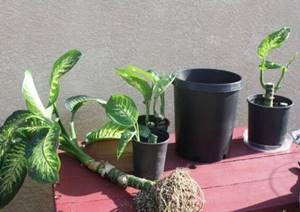
Transplantation is necessary for indoor plants, first of all, in order to move it to a larger container for normal development.
The soil for Dieffenbachia should be of medium density.
That is, not excessively loose, and not dense.
To replant, you must carefully remove the plant from the pot along with the soil and move it to a larger container.
The pot for Dieffenbachia should be selected in size according to the growth of the plant. Tight will not work, too big for a growing flower is also not needed.
This video shows in detail how a Dieffenbachia transplant is performed:
Nuances during transplantation
As the root system grows, the Dieffenbachia will need to be transplanted into a larger pot.
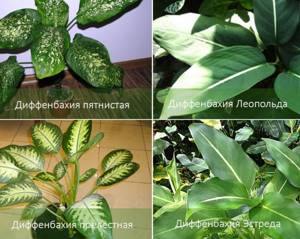
You can determine when the time has come by the following signs:
- New shoots and leaves stopped appearing.
- New leaves are smaller in size.
- When the microclimate is maintained, the soil dries out quickly.
You need to prepare in advance for transplantation, purchase a pot or tub 2-3 centimeters larger in diameter than the previous one.
To form drainage, buy expanded clay, and for backfilling, buy fresh specialized soil.
The optimal time to move a flower is considered to be the beginning of spring. During this period, the plant has not yet emerged from winter rest. Feeding should begin afterward, so as not to awaken the Dieffenbachia ahead of time and not injure it.
Planting a flower in a new container is done as follows:
- A 2-4 cm layer of expanded clay is placed at the bottom of the new pot.
- Dieffenbachia is removed, the blackened and dried roots are carefully cut off, and the cut sites are treated with antiseptic and antifungal agents.
- Place it carefully in a new tub and gradually add fresh sterilized soil along the edges, slightly compacting it.
- Water with settled water at room temperature.
As a rule, young plants need to be replanted approximately once a year. They grow actively, and their root system quickly fills the container. It is enough to rejuvenate older plants when the trunk has grown strongly and become bare.
How to care for Dieffenbachia at home?
Dieffenbachia is considered an unpretentious plant for home cultivation, so you should not be afraid to try it yourself.
It is important to first study the features and recommendations for self-cultivation, which will be useful for beginners and professional gardeners.
About the soil for the plant
If a beginner gets a plant without soil, he needs to purchase it at the store.
It is necessary to choose a substrate intended for growing flowers of the genus Dieffenbachia.
If you don’t have it, you can prepare the soil for planting yourself. To do this, mix earth, sand and peat in equal parts. Add to the mixture 1.5 times more of the resulting composition of turf soil.
To plant, you need to lay drainage made of expanded clay or ceramic fragments at the bottom of the pot - whatever you find in the house. It is important to ensure the soil is loose and well-ventilated, so broken bricks are added to the soil.
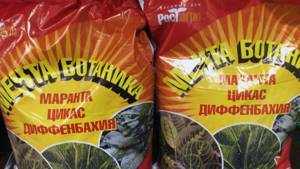
Lighting
For any flower grown at home, it is important to create lighting favorable for growth. Otherwise, the plant may slow down in growth and lose its true color.
As for Dieffenbachia, the western or eastern side has a positive effect here; it is permissible to place the flowerpot on the northern window. Leaves should not be exposed to direct sunlight as this will cause yellowing or darkening.
If the house is located in such a way that little light will reach the plant, additional lighting must be installed.
Otherwise, the leaves are crushed and Dieffenbachia will lose its attractiveness.

Watering
The root system should not be over-moistened, as this will lead to the development of flower diseases. In spring and summer, moisten the soil as it dries - it is recommended to do this in small quantities, but often. In winter, the frequency of watering is reduced.
For irrigation, use only water that has stood for 2 days.
If there is a large amount of bleach in the water supply, it is necessary to soften the water by adding a small amount of citric acid.
Add powder in the amount of a pinch per liter of water. This procedure is not carried out regularly, but only for 3-4 waterings.
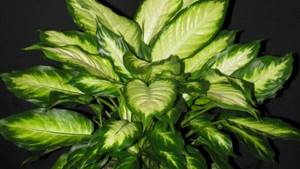
Temperature and humidity
The temperature for Dieffenbachia must be maintained at the required level for favorable development at all times. It is recommended to comply with the following requirements regarding plant care:
- The temperature is adjusted depending on the season.
- In spring and summer, the temperature should not rise above 22 degrees Celsius. But Dieffenbachia can tolerate up to 30 degrees of heat during hot periods. Therefore, in the spring and in the absence of heat, it is recommended to install the plant on the windowsill. In the summer, you need to move the pot deeper into the room and use a fan or air conditioner at home to reduce the temperature.
- In winter, it is necessary to reduce the temperature to 18 degrees Celsius. Since this cannot be tolerated in a house, the flower is simply removed away from heating devices. Temperatures below this may cause leaves to fall.
- Dieffenbachia does not like dry air, so it is recommended to place a humidifier in the room. It is important to maintain air humidification in the house at 60%.
- If you don’t have a humidifier, you can place a container of water or an aquarium next to the pot. It is also recommended to place gravel in a tray and moisten it regularly.
If it is not possible to comply with the presented requirements, it is enough to wipe the weeding plants daily with a wet cloth.

About fertilizing
The presented plant grows regardless of the seasons, so it is almost impossible to distinguish the time of rest and active growth.
As a result, the flower is fertilized regularly throughout the year every two weeks.
In winter, the frequency of feeding is reduced to 1.5 times a month. For feeding, complex mineral fertilizers are used, which are intended for deciduous plants.
If a variety with a large number of white spots on the leaves is grown at home, use fertilizers with a low nitrogen content.
Otherwise, you may experience greening of the white parts.
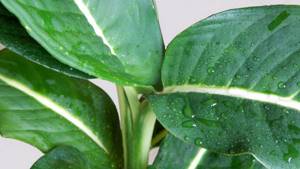
Transplanting a plant
Like any plant, Dieffenbachia needs annual replanting. For the procedure, the time chosen is early spring and spring (from February to May).
It should be noted that the root system of Dieffenbachia is fragile, so for replanting they use the transshipment method - this is removing the root with an earthen lump and then planting it in a new pot.
The point of replanting is to enlarge the pot. Its diameter increases by 2-3 cm.
Dieffenbachia: transplantation and cuttings. Video:
Rejuvenation
A bare long trunk makes it uncomfortable to care for a plant that requires additional support. In addition, the decorative effect suffers greatly, because instead of a lush bush, a bare stem stretches upward.

There are two ways to return Dieffenbachia to its aesthetic appearance:
- By pinching the growing point on the crown, this will probably awaken the dormant buds on the trunk and force the flower to produce new shoots.
- Trimming the crown and its subsequent rooting. To do this, the top is cut off approximately at a distance of a couple of centimeters from the node in which the dormant buds are located. The oozing stem is blotted dry and sprinkled with activated carbon. Then it can be planted in a new pot with loose, non-moisture-absorbing soil. It is important not to overwater a new plant to prevent the root and trunk from rotting before the roots grow. The remaining nodes of the long stem can be divided into cuttings and planted. New Dieffenbachia will grow from them, indistinguishable from the mother one.
Transfer rules
As the crop grows, it needs to renew the land. Dieffenbachia must also be replanted as the root system fills the space in the pot. In some cases, this procedure is carried out twice a year, and it is best to do this between February and May.
The pot is selected to be a couple of centimeters larger in diameter than the old one. A decent drainage layer of pebbles, expanded clay or broken brick is placed in it. Then the earthen ball, together with the root system of the plant, is transferred into a new container. There is no need to clean the soil from adhering elements of old drainage. After this, the required amount of slightly acidic fresh loose substrate is added, which consists of 1 part peat, 2 parts leaf soil, as well as 1 part fine sphagnum and half part coarse river sand.

Reproduction
It is very difficult to achieve natural flowering and seed ripening at home. Dieffenbachia reproduces well by vegetative means. Cuttings can be obtained at any time after cultivation of an adult plant. It is better to pinch the only growing point for the appearance of layering no earlier than 3-4 years of growth after planting.
It is better to root layerings and cuttings in an improvised greenhouse, which can be replaced by a transparent plastic bag or film.
Benefit or harm?
If the juice of this plant gets on the skin or mucous membrane, it provokes redness, burning, swelling, as well as temporary numbness, as if under local anesthesia. If this liquid enters the stomach, severe salivation, paralysis of the vocal cords and vomiting will follow. Dieffenbachia is best placed at home out of the reach of children and pets together. If such an unpleasant situation does occur, then you must immediately rinse your mouth with plenty of water, drink activated charcoal, and then seek help from a doctor.
This plant is popularly considered a weed, so it is mercilessly destroyed, making sure that the remains do not end up in livestock feed. Previously, poison for insects and rodents was made from Dieffenbachia. It was also used as a rod to punish slaves; they then suffered for a week after such execution. However, indoor varieties of this crop are much less poisonous than their wild counterparts.
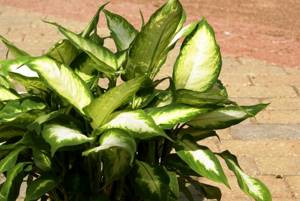
On the other hand, experts say that this plant may also provide some benefits. NASA data suggests that the culture, along with dracaenas and ficus trees, is capable of purifying the air of toxins. In particular, it fights benzene, selenium, formaldehyde, and trichloroethane. That is why, in indoor conditions, it is best to place Dieffenbachia in the kitchen.
Errors in care and their signs in the plant
Healthy Dieffenbachia delights owners with juicy, bright, large greens. If the cultivation rules are not followed, the plant communicates the problem with a corresponding appearance.
| Changes | Possible reasons |
| The ends dry out and crumble |
|
| Fading leaves, loss of contrast |
|
| Small misshapen leaves | Soil is too alkaline |
| The lower leaves dry out and fall off | cramped potty |
| Pale and softened stem | Root Rotting |
| The leaves are curling |
|
| Brown edges |
|
| Yellow leaves |
|
Dieffenbachia flower
Many of us love indoor plants. They enliven the interior and add a piece of nature to it. With their appearance, positive energy is added to the room, which will promote creative thinking in offices and harmony at home. One of these is the tropical dieffenbachen flower - a type of indoor plant with wide, bright leaves growing densely on a thick base. The trunk is extremely fragile, which requires careful handling of the flower while transporting it from place to place. But even if the main stem of the flower suffered for some reason, there is no need to be very upset about this, because It is quite enough to trim the top a little and strengthen the rhizome somewhat.
Today you can find the following varieties of Dieffenbachia:
- Adorable (or pleasant);
- Large-leaved;
- Spotted
Rare housewives can keep Dieffenbachia at home, because... The first buds will appear only if it is pollinated regularly.
Difimbachium requires a certain amount of careful care. The better care you take for this flower, the longer it will delight you with its appearance and decorate any space.
The direct care regimen will depend on the variety of Dieffenbachia. For example, the Camilla variety loves not too cold winters (about 18 degrees) and not hot summers (not higher than 22 ° C). Interestingly, the plant can withstand thirty-degree heat with systematic watering and moistening of the leaves. Also, the plant does not like frequent ventilation, because... this provokes drying of the tips of the leaves, therefore, if you intend to open the window, it is better to move the delicate flower to another place.
Some are scared off by the claim that this flower is poisonous and this capricious young lady is dangerous for the home. This is explained by the fact that Dieffenbachia juice can cause a burn or allergy. However, this can be avoided with careful handling and proper care.
Diseases and parasites
With proper and sufficient care, Dieffenbachia has good immunity to viruses, fungi, bacteria and pests. However, errors in maintenance or proximity to an infected plant lead to disease. Pathogens must be dealt with in a timely manner. The price of delay may be the death of the flower and infection of other indoor plants.
Any sign indicating weakness of the stem and leaves should be a reason for preventive and treatment measures.
| Pathogen | Characteristic signs of infection | Help |
| Soft rot | The leaves turn pale and wither, the stem cracks at the base, the flower stops growing and looks withered, the soil may smell moldy. | It cannot be cured, but you can try to root the crown or get cuttings from a healthy section of the stem after pruning. |
| Bacterial leaf infection | Yellow spots with a darkish clear border. | Treat with fungicides. |
| Late blight | Dark rot rises from the root, the plant weakens and withers. | The flower will have to be completely destroyed. |
| Anthracnose | Weeping dark spots appear on the leaves. | Cut off the infected parts, make the air drier than usual, systematically treat the remaining healthy leaves and stem with a solution of fungicides. |
| Aphid | The leaves begin to deform and turn yellow, and a sticky coating appears. | Wash the plant with soapy water and treat with special pesticides or tobacco dust. |
| Shchitovka | The appearance of light brown plaques on the trunk and sticky discharge. | It is necessary to remove all pests manually, lubricate the affected areas with alcohol or kerosene, and treat the entire plant with insecticides. |
| Chervets | Cloudy thick discharge on the petioles and in the veins. | Treat with mineral oil and specialized preparations. |
| Spider mite | Characteristic small brown dots on the leaves, dry areas and a thin cobweb on the cuttings. | Wash with soapy water and spray with a special product. |
| Thrips | Whitish coloration of individual parts of the plant, withered and drying leaves. | Treat thoroughly and repeatedly with strong insecticides. |
Possible diseases
We figured out how to care for Dieffenbachia at home. Now let's look at the main diseases and ways to combat them:
Parasites are pathogenic microorganisms that feed on the sap and flesh of plants:
- aphids reproduce and live in colonies on the trunk and stems, destroying their structure. They suck liquid from the plant;
- Spider mites grow between the nodes of the trunks. The main symptom is the appearance of cobwebs and the falling of leaves;
- Thrips are small bugs that feed on Dieffenbachia sap. As a result, the leaves fall off and the plant withers;
- Mealybugs are insects that feed on leaves. Because of this, they lose their shape. They curl and dry. If treatment is not started promptly, scale insects can lead to death.
Diseases quite often affect the plant. These are mainly fungal diseases , which have different localization and symptoms:
- Anthracnose is a pathology that manifests itself as excessive spotting on the foliage. Because of this, it dries out and falls off. The main reasons are excessively wet soil in the pot, high room temperatures and dry air;
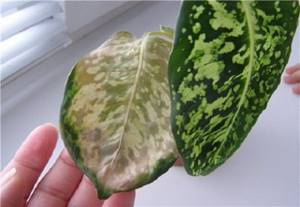
- spotting that appears along the edges of the foliage, starting from the lower ones and spreading over all leaves. These spots lead to the leaf drying out and dying;
- Fusarium appears as dark spots, then the plant completely withers and dies. Infectious pathogens can live in the soil for a long time and not show obvious signs, and then they occupy the plant and begin to “eat” it from the root;
- Root rot occurs most often due to overwatering. If there is a lot of moisture in the soil, mold and rot begin to form in it, affecting the plant.
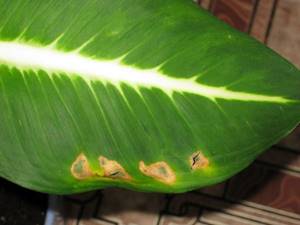
Viral diseases are mainly manifested by the appearance of circles on the surface of leaves:
- bronzeness is manifested by the appearance of red circles on the foliage. Infected leaves usually die;
- mosaic is a disease that is manifested by the appearance of foliage in a mosaic pattern.
Most diseases can be cured by normalizing care. Dieffenbachia is not very whimsical; it is important not to overdry it, not to overwater it, not to freeze it, and to spray it regularly.
When the first symptoms of a viral or parasitic disease appear, you must go to a specialized store to purchase medicine for the plant. By treating the soil and leaves, you can kill bacteria and create comfortable conditions for the growth of Dieffenbachia.
Mr. Summer Resident warns: Dieffenbachia is poisonous
The milky sap of the plant is not poisonous. It does not cause severe poisoning, disturbances in the central nervous system or breathing.
However, the high content of bioactive substances can seriously irritate the skin and mucous membranes. Thus, a child or a pet may be harmed by a flower, who, out of curiosity, will break it off or bite it.
This does not threaten your health, but just in case, you need to take measures to prevent the development of chemical burns and allergies.
Growing Dieffenbachia in the house is useful; it perfectly purifies the air, absorbing phenol, formaldehyde and heavy metals from it. The released phytoncides inhibit the spread of viruses and bacteria through the air. Maybe that’s why the flower is so common in the halls of medical institutions.
Signs
The photo with Dieffenbachia shows how beautiful this flower can be grown at home. Many people probably know that there are many signs and superstitions associated with this culture. People who are accustomed to looking for an explanation for their own troubles and problems by the state of the planets, mystical laws, and the horoscope are often interested in the influence of Dieffenbachia. So is it possible to keep Dieffenbachia, a photo of which can be seen in this article, at home?
Along with hibiscus, Dieffenbachia is considered to be the strongest fly-driver. In addition, there is a belief that families in which this flower is grown will not have children, since men lose the ability to conceive. This is why you should not keep Dieffenbachia. The photos demonstrate how attractive this flower can be grown. Does it really have such a negative effect on the energy in the house? There is still no reliable data confirming this.
There is another interesting fact that explains why Dieffenbachia, the photo of which you saw in our article, cannot be kept in the bedroom. The fact is that the culture absorbs oxygen. But some experts refute it.
Care: difinbachen flower
Dieffenbacher is a rather capricious plant that needs some and regular care. Considering the main tropical habitat of its habitat in nature, Dieffenbachia loves a shaded place and the amount of sun it needs will be determined by the type of flower. So, for a variegated southerner, the light should not be direct, but diffused, so as not to inadvertently burn the natural pattern on the leaves. If the leaves are matte and have a solid pattern, then in the summer it is better to place the flowerpot in a more shaded area of the room, and in the cold season it is better to provide the “tenant” with an auxiliary light source.
It is necessary to protect the flower from hypothermia and strong winds. It is also important to provide the plant with a sufficient level of moisture by watering and spraying daily.
These flowers need to be watered with either boiled or infused water every 2-3 days.
Good flower growth can be ensured by properly selected mineral fertilizer and correctly selected soil.
Periodically, the top of the plant should be trimmed. To do this, using a sharp knife, you need to trim the bare trunk as close to the soil layer as possible. You need to cut carefully, at a right angle, so as not to touch the emerging rudiments. Next, the cut should be sprinkled with ground activated carbon to prevent possible diseases.
One of the options for optimal care is a correctly performed transplant. Attention! Transplantation is performed at the moment when the pot for the plant becomes too small.
The transplant rules are as follows:
- First you need to provide the plant with the necessary soil composition. You can prepare it yourself, or you can purchase ready-made soil.
- Before transplanting, the soil of the flower must be dry.
- To make it easier to remove the plant, you need to tap a little on the rim of the pot.
- The top layer of soil must be removed.
- When removing, the plant must be carefully held by the trunk and roots.
- Trim off painful areas of the root system and remove excess soil.
- Spread the rhizome a little.
- Transfer the flower to a new container and cover it with fresh soil.
It is best grown in clay or wooden pots to help it last longer.
How to feed
– we usually fertilize during the active growth phase and after the dormant phase. This is spring until the very end of summer. We use liquid mineral fertilizers that can be diluted in water for irrigation. In the summer we feed twice a week. But during the rest period - once a month. Use organic liquid fertilizers that contain nitrogen.
Dieffenbachia reproduces very well. When propagating, you can use stem or apical cuttings. In principle, the plant is resistant to pests, but if a number of growing conditions are violated, minor problems may arise. Due to violation of the watering regime, all kinds of rot of roots and stems can occur. Viral and fungal diseases. Pests include scale insects, mealybugs, spider mites, aphids and thrips. As a problem arises, we carry out preventive measures; if a disease or pest is detected, we use the appropriate medications.

When composing compositions from Dieffenbachia, we take into account its size and growth characteristics. Tall and large plants can be planted in groups in one pot, and used as a single plant. More compact forms can be planted at the foot of adult Dieffenbachias. Or place it next to the main plant. They can also be combined with decorative foliage and flowering indoor plants. It is worth paying attention to Dieffenbachia sublim, Dieffenbachia mix, Dieffenbachia mix, Dieffenbachia reflector, Dieffenbachia bush. Good luck to you.



